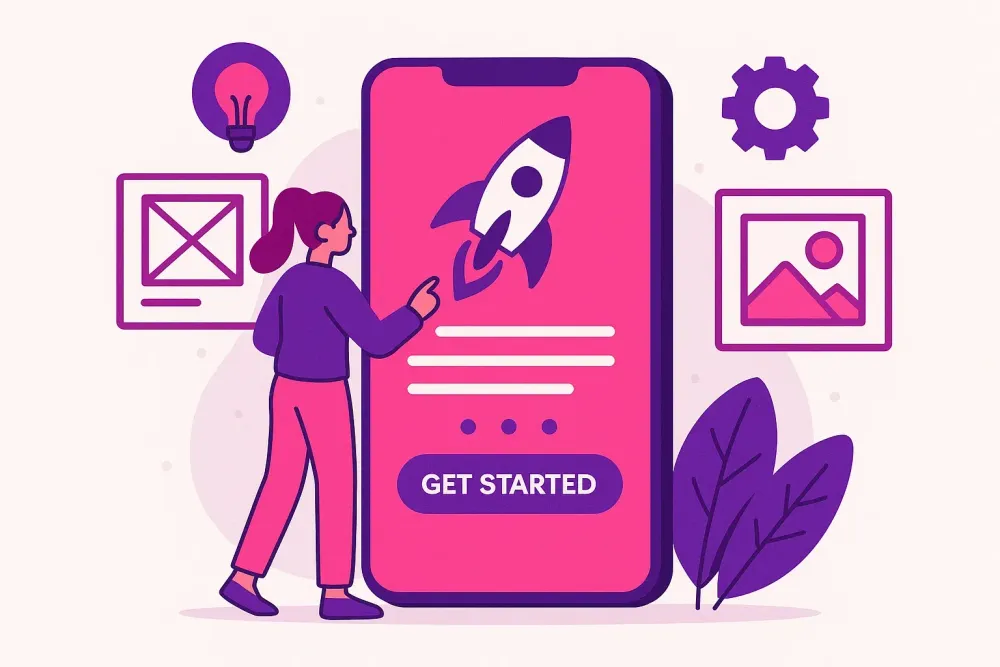Home
Services
Products
Projects
Who We Are
Blogs
Contact Us

Optimizing Mobile App Onboarding: Strategies, UI/UX Best Practices, and Examples
Effective mobile app onboarding bridges the gap between the developer's intimate knowledge of an app and the user's first encounter. While developers meticulously research, design, and test interfaces for their target audience, users approach the app fresh. This disparity can lead to confusion and frustration, ultimately hindering adoption. A well-executed onboarding process empowers users to navigate the app seamlessly, transforming initial hesitation into confident engagement.
Negative first impressions stemming from usability issues can significantly impact a user's willingness to continue using an app. Onboarding addresses this by guiding users through the app's core functionalities, fostering understanding and a positive user experience. A thoughtful onboarding strategy minimizes user churn and maximizes long-term engagement.
This article delves into the importance of a robust onboarding process, exploring various approaches, UI/UX best practices, and real-world examples to illustrate how effective onboarding contributes to improved user experience, increased conversions, and sustained user engagement.
What is Mobile App Onboarding?
Mobile app onboarding encompasses the initial steps a user takes after downloading an app. It involves guiding users through registration, educating them about the app's features, acquiring necessary permissions, and gathering relevant information. Essentially, it's the process of providing support and guidance to ensure a smooth and successful user journey.
The onboarding journey begins the moment a user downloads your app. Success hinges on demonstrating the app's value proposition and how it addresses user needs. Consider it a mutually beneficial "first date." The onboarding process should efficiently guide users toward achieving their goals within the app, creating a positive and lasting impression.
Three Approaches to Mobile App Onboarding:
- Progressive Onboarding: This approach encourages users to learn by doing, gradually revealing information as they explore the app. It's ideal for apps with complex workflows, multiple sections, or gesture-based interactions. Progressive onboarding provides context without overwhelming users, allowing them to control their learning pace.
- Functional Onboarding: This method focuses on quickly demonstrating the app's core features and functions. Visual tours and step-by-step instructions are common examples. Functional onboarding helps users understand the basics and get started quickly.
- Benefits-Oriented Onboarding: This approach emphasizes the app's value proposition upfront, showcasing its benefits before delving into the "how-to." For example, highlighting how the app can improve productivity or simplify a task. This approach resonates with users by demonstrating the app's potential impact on their lives.
Why is Mobile App Onboarding Important?
Users can easily become frustrated if an app's UI deviates significantly from familiar patterns. If it takes too long to understand the app's functionality, a substantial percentage of users will abandon it. A well-crafted onboarding experience mitigates this risk.
Onboarding is crucial for creating a positive first impression and encouraging continued app usage. It sets the stage for a successful user journey and contributes significantly to long-term user retention.
10 Benefits of Effective Mobile App Onboarding:
- Increased long-term user retention and early app usage
- Seamless user experience
- Valuable customer insights
- Reduced customer acquisition costs and increased engagement
- Opportunity for real-time customer service
- Improved customer loyalty and satisfaction
- Faster realization of app value
- Personalized user experience
- Smooth transition from novice to experienced user
- Effective communication of brand value and app usage
Mobile App Onboarding Examples:
- Slack: Slack's chatbot-driven onboarding simplifies the desktop experience, guiding users through setup and connection with colleagues in a concise and engaging manner.
- Venmo: Venmo showcases its core value proposition and social proof immediately upon launch, displaying a live feed of transactions, highlighting its widespread usage and diverse applications.
- Calm: Calm's minimalist UI design and brief onboarding process effectively communicate the app's key benefits, allowing users to quickly set goals and begin their meditation journey.
- Masterclass: Masterclass's onboarding emphasizes the app's benefits in a visually appealing format, encouraging course browsing and exploration even before signup, offering users a risk-free preview.
- Fitbit: Fitbit's onboarding seamlessly guides users through device selection, setup, and account creation, breaking down a potentially complex process into manageable steps.
Design Examples of Mobile Onboarding Applications:
- Instagram: Leveraging Facebook's social network, Instagram pre-fills form fields, suggesting connections, and creating a sense of community, encouraging engagement and completion of the onboarding process.
- YouTube Music: A sleek design with contrasting colors highlights key elements and calls to action, including a prominent free trial button, empowering users with choice and building trust.
- Mailchimp: Offering a "Skip the tour" option on every screen puts the user in control, allowing them to exit the onboarding sequence at any time, enhancing user autonomy and satisfaction.
Frequently Asked Questions About Mobile App Onboarding:
How do I onboard users to my mobile app?
Successful onboarding starts with a positive user experience. Focus on understanding your users, simplifying navigation, using a clean color scheme, and minimizing clutter.
Is app onboarding necessary?
While not all apps require extensive onboarding, it's valuable for educating users and gathering insights. Simpler apps may benefit from contextual tips rather than full tutorials. Complex apps can leverage "teachable moments" within error messages to provide targeted guidance.
Why is the onboarding screen important?
Onboarding screens serve three primary purposes: explaining core functionalities and benefits, facilitating account setup (including password creation), and gathering user profile information for personalized content and notifications.
See More
Contact Us
Let’s make your Idea into Reality
Let's Talk
© Copyright DEFX. All Rights Reserved
GoodFirms ★ 4.2
Clutch ★ 4.2
Google ★ 4.2
